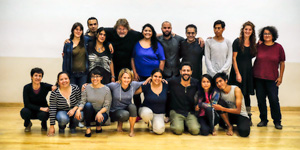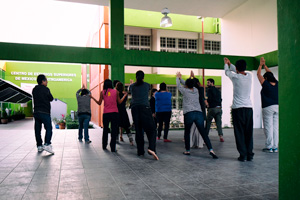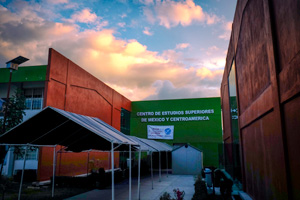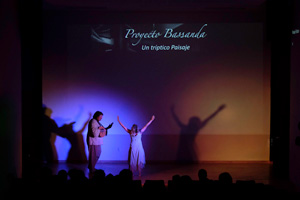New Course Allows for Unique Art Collaboration with Mexico
Critical Issues in the Arts will allow students to create a collaborative performance with students from Mexico:
Forget the classroom. One Texas Tech University professor is taking students to a magic city.
Musicology professor Christopher Smith is leading the Critical Issues in Art and Culture course (VPA 2301), a two-week summer course in Chiapas, the southernmost province in Mexico. It will be an intensive fortnight of brainstorming ideas, discussing the messages in art and how to convey emotions and thoughts through music, dance and theatre, culminating with a performance that is the brainchild of the students in the class.
Oh, and those students won't just be music and dance majors from Texas Tech. The course is open to any undergraduate student from Texas Tech, Texas State University and Tecnológico de Monterrey, the university in Chiapas that will host the class. The course will be taught on stage, in sound rooms, out among the mountains and in the ruins of San Cristobal de las Casas.
"We're really trying to have it be a truly international and interdisciplinary intensive experience," Smith said. "It's making art in this study abroad situation."
The course, in its inaugural year, will be taught by Smith and Texas State dance professor Nicole Wesley along with graduate student Marusia Pola, a native of Chiapas. It's exciting for the professors to consider the collaboration and creativity they're anticipating in this magic city.

"It enriches you as an artist and the way you work when you immerse yourself in a place that's not familiar," Wesley said.
Pola, who is thrilled to introduce more people to her home, agreed. There are dozens of study abroad classes, but this one will immerse the students in a foreign culture, including going to class with students from Mexico.
"It's a real study abroad experience," she said. "You're not going to go to a classroom, working with American teachers. You're going to be working with Mexican teachers, you're going to be working with Mexican students, so the collaboration is going to really happen."
What the class will look like:
The class won't be made up of only musicians and dancers, Smith said. Students from any major are welcome, whether they have an artist's background or not.
"It helps, but we're quite committed to an open-ended, experimental opportunity," he said.
Nor should the musicians who come expect to only play music or the dancers to just dance. All of the students will take part in the creation and performance of the final project. Smith and Wesley will be there to guide, suggest and help create, but it's not their performance, Smith said. Neither would presume to tell their students how art must be made or what it must look like.
"Nicole doesn't just make up a choreography and find five dancers and stick their bodies in place," Smith said. "I don't just write music for 26 players and say any 26 players will do. Both of us as artists are really committed to letting singers and players and dancers have a role in deciding what the piece is."
"We're altering the way we work as artists in our own primary discipline," Wesley said.
There also isn't a defined syllabus – no chapters to read, homework to do or tests to take. The course is meant to explore and define art, with the students creating the content as they go.

Because the students come from three different universities, two different countries and a variety of backgrounds, participants can expect a unique two weeks. It will not be a blow-off course, though; students will learn and do plenty. Smith described it as intensive more than once. They'll do improvisation or movement exercises, like acting out sorrow or requiring a musician-dancer duo to perform while connected at the hip.
The point is to get students comfortable with their bodies and connecting with other people.
"It's through the act of doing and being and experiencing that our students learn," Wesley said.
What the performance will look like:
Short answer: No one knows yet.
Pola thinks the performance will mirror what the Celtic Ensemble does – a process of sharing ideas, singing and dancing, trying new things, possibly failing and trying something else that leads to work of art that comes to life on stage. Wesley said the process looked like playing – improvisation and manipulating music and dance.
"You'll have chances to go a little bit outside of your comfort zone and have a little more awareness of your own body and what it means to work in a communal space," Pola said.
When the group scouted the San Cristobal site in August, they gave a two-day workshop for a group of graduate students. They also, overcome with the emotion and art present in San Cristobal, created their own impromptu performances in the street, with Smith on guitar and Wesley dancing. In a city filled with artists from around the world, this fit in.
"We would love to do an outdoor performance," Wesley said. "There are some beautiful places."
The students' performance likely will carry echoes of those street performances, but it will not be the same. Smith considered ideas – perhaps the students would use art to address a political issue. He frequently came back to immigration and the idea of a border, an issue all of the students, both Mexican and American, can understand. Chiapas shares a border with Guatemala. It is the "first border" to the United States, the first test Central Americans face before the 1,500-mile journey through Mexico to the U.S. border.

"What we really want to do is make a piece there that is expressive of that group of people and that experience, that they co-create and perform it there, and then we want to bring it back here," Smith said. "The students from Mexico who have been equal collaborators get to come and visit us, and we do the piece again. That would be a true equal collaboration."
What Chiapas is like:
Smith and Wesley looked at another university in Mexico, but ultimately the program didn't work out. When the option to travel to Chiapas arose, they looked into it more. Every piece fell into place.
Chiapas is a mountainous region; San Cristobal, where the class will spend its second week, is about 8,000 feet in elevation. It was founded by conquistadors, is about 30 percent Indio (the indigenous people of Mexico) and is home to 17th-century architecture and a baroque cathedral.
It's not just full of beautiful scenery, however. San Cristobal has an artist's soul, Smith said. The Mexican government designated it as a "magic city" – it's arts-centric and a huge part of the country's cultural tourism. Tuxtla, where the students will spend their first week, is home to Tec de Monterrey.
Pola also was an excellent ambassador for San Cristobal. She talked about its energy and vitality, and when the two professors, Pola and photographer Tif Holmes went in August they felt a deep connection to the artistic community and history that permeated San Cristobal.
"At the end of the trip Nic and I knew we had to come back here," Smith said. "This is the place we need to come. This is an artistic city and it's beautiful and there are local artists and teachers who really want us to be here."

Chiapas also has another, more practical benefit: it's much less expensive than other study abroad opportunities. The two-week trip, excluding tuition, will cost about $1,200. Smith sees this course as a way for students who want a study abroad experience but can't afford a month in Rome or Paris. It's a chance for students to experience the real Mexico instead of the tourist-filled beaches or the cartel-filled headlines.
It will be worth it, Smith is quite sure. Students will learn about art, Mexican history and themselves and be a part of something beautiful.
"To create something of beauty is a profoundly human thing to do," he said.
International Affairs
-
Address
601 Indiana Avenue, Lubbock, TX 79409-5004 -
Phone
806.742.3667 -
Email
oia.reception@ttu.edu
